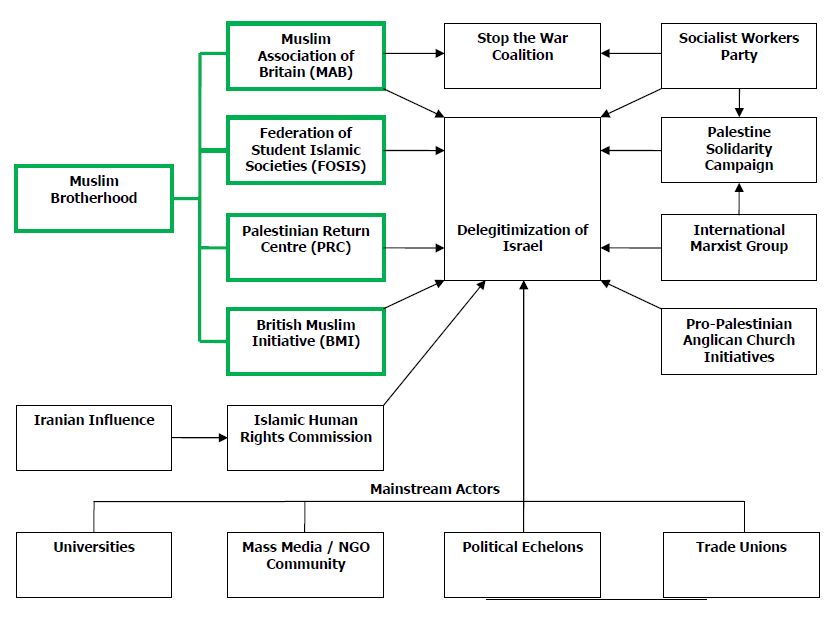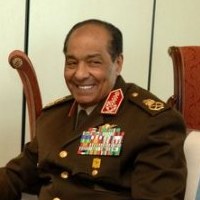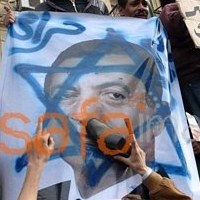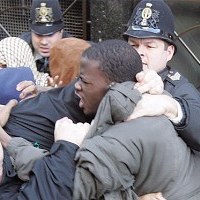![]()
January 2012
This study updates and supplements the ITIC’s June 2011 study of the Muslim Brotherhood. It examines the Muslim Brotherhood in Egypt and other Arab countries in the wake of the past year’s regional uprisings. It deals with the nature of the movement in each country, its relations with the various regimes and evaluates its chances of exploiting regional unrest to its own ends. It also examines the Muslim Brotherhood’s branches in Western European countries and the implications of its activity for both internal European affairs and the Palestinian-Israeli conflict.
The Inception and Growth of the Muslim Brotherhood in Europe
Several non-Egyptian branches of the Muslim Brotherhood were established early in the movement’s history, in 1928-1954. However, the main catalyst for its spread outside Egypt was the systematic oppression of Egypt’s President Gamal Abdel Nasser in 1954. In the 1950s two large, well-organized Muslim Brotherhood groups fled from Egypt to Saudi Arabia and Qatar. A third, less cohesive group of activists fled to the United States and a number of European countries, including West Germany.
In Germany, the Muslim Brotherhood activists first integrated into the Muslim community and then spread to university campuses and the left-wing opposition. Over the next several decades it gradually established itself in other European countries and became responsible for the spread of radical Islam in the West and the de facto representative of the Muslim immigrant communities. The various organizations, networks and activists in Europe often deny their affiliation with the Muslim Brotherhood, particularly after the September 11 terrorist attacks.
Using financial assistance from the Persian Gulf states (which continues to this day), the movement expanded its infrastructure in Europe and the United States by creating a network of banks, mosques, research centers, Islamic institutes, and social and educational institutions that spread the Muslim Brotherhood’s political radical Islam to the Muslim communities in Europe. According to an article written by Ehud Rosen on the Muslim Brotherhood in Europe, the movement currently claims to have branches in over 80 countries across the globe.[67]
The most prominent Islamic centers in Europe directly or indirectly affiliated with the Muslim Brotherhood are currently located in Britain, Germany and France (for a long time, Munich was a major base of its operations). Prominent institutions in these countries include the Islamic Society of Germany (IGD), France’s Union of Islamic Organizations,[68] and the Muslim Association of Britain (MAB).
A prominent figure in the growth of the Muslim Brotherhood in Europe was Sa’id Ramadan (“little Hassan al-Banna”). He was married to Hassan al-Banna’s daughter Wafa; his son is Tareq Ramadan, one of today’s most prominent Islamist thinkers in the West. Sa’id Ramadan joined the Muslim Brotherhood at the age of 14, and over the years was also influenced by Sayyid Qutb. He had a major role in establishing relations for the Muslim Brotherhood in the Middle East, Pakistan and Europe. He played a key role in establishing the IGD and creating the movement’s first mosque in the West, in Munich, Germany. The high point of his activity was the establishment of the Islamic Center in Geneva (1961), currently directed by one of sons. Prominent among the financial figures of the Muslim Brotherhood network in Europe was a businessman named Yousef Nada, born 1931, who for many years was considered the movement’s international finance person.
The Muslim Brotherhood’s Umbrella Organizations in Europe
In the late 1980s and 1990s the Muslim Brotherhood created several umbrella organizations in Europe, most of them influenced by Qatar-based Sheikh Dr. Yusuf al-Qaradawi. The Federation of Islamic Organizations in Europe (FIOE) was established in 1989. Until recently it operated from Britain, but in 2007 it relocated to Brussels. The FIOE currently has 28 member organizations in EU countries (including Scandinavia and Eastern Europe) and non-EU countries and territories (e.g., Kosovo, Turkey, Moldova, the Ukraine and Russia). The social network created by the FIOE consists of mosques, schools for Quranic studies, Islamic culture centers and various Muslim associations. The Muslim Brotherhood is based in Britain (see below) but also has considerable presence in Germany and Belgium.
The FIOE is headed by Chakib Ben Makhlouf, from Sweden. It is directed by an executive committee with an organizational structure similar to that of the Muslim Brotherhood (there are sections dealing with such diverse issues as education, media, the da’wah and women, as well as regional subdivisions). The FIOE oversees other organizations, including the Federation of Muslim Youth and Student Organizations, the Federation of European Arab-Islamic Schools and the European Assembly of Muslim Imams.
In 1997 Yusuf Qaradawi established the FIOE’s Dublin-based theological wing, the European Council for Fatwa and Research (ECFR), headed by headed by Hussein Halawa. Its objective is to promote Islamic religious law (Shari’ah) in Muslim immigrant communities in Europe. In 2004 al-Qaradawi established the International Union of Muslim Scholars (IUMS), which includes around 500 Islamic scholars from across the world. It was launched in London in July 2004, when Qaradawi was invited to Britain by London’s anti-Israeli mayor Ken Livingstone.
The European Muslim Brotherhood’s Sympathy for Hamas
The Muslim Brotherhood in Europe, particularly Britain, sympathizes with the Palestinians, in general and with Hamas in particular. It expresses solidarity with Hamas and inspired by Sheikh Qaradawi has even declared support for suicide bombing attacks against Israeli civilians. The Muslim Brotherhood in Europe plays a major role in the anti-Israeli delegitimization campaign currently being waged. To that end it has joined forces with radical left-wing elements, with which it shares an anti-Israeli platform, despite the ideological differences between them.
The presence and activity of Muslim Brotherhood activists is notable in several fields: organization of convoys and flotillas to the Gaza Strip (the Muslim Brotherhood, in close cooperation with the Turkish IHH, played an important part in organizing the Turkish flotilla which ended in a violent confrontation on board the Mavi Marmara); intensive anti- Israeli propaganda (during annual conferences and through Arab and European media); insistence on the Palestinian refugees’ so-called “right of return” as a means of destroying the State of Israel (the leading organization in this field is the British PRC, controlled by the Muslim Brotherhood and Hamas operatives).
Muslim Brotherhood Activity in Turkey
Since 2006 Turkey has been a center of intensive Muslim Brotherhood activity. The ruling AKP party allowed Muslim Brotherhood activists and organizations, including Sheikh Yusuf al-Qaradawi’s IUMS, freedom of action in Turkey, an example of which is the seven conferences and fundraising events held in Istanbul in recent years.[69] The first was held in July 2006 and was attended by Al-Qaradawi, who called it “The [Conference of the] Muslims in Europe” (which reflects how the Muslim Brotherhood conceives of itself as the representative of Europe’s Muslims).
The most important conference was held in Istanbul on February 14-15, 2010. It was attended by approximately 200 activists and clerics from the Arab-Muslim world and Muslim communities in Western countries (many of them affiliated with the radical Islamic ideology of Hamas and the Muslim Brotherhood). Ninety of the activists who took part in the conference signed a jihadist charter (“The Istanbul Declaration”) calling for the fulfillment of the duty of jihad and “resistance” [i.e., terrorism] against Israel (“the Jewish Zionist occupation”). The conference also called for more assistance to jihad and the “resistance” with money, weapons, clothes, food, medical supplies and other materials, and stated that the Palestinian Authority did not represent the Palestinian people.[70]
After the events in Al-Tahrir Square in Egypt began, the Muslim Brotherhood joined the Turkish Islamic organizations calling for Mubarak’s immediate resignation. On February 5, 2011, a demonstration was held in Istanbul led by IHH and its leader Bülent Yildirim. One of the participants was Dr. Ashraf Abdul Ghaffar, a Muslim Brotherhood leaders in Turkey. During the demonstration, Bülent Yildirim implied that other Middle Eastern leaders might meet a fate similar to Mubarak’s (ihh.org.tr).
Britain As a Center of Muslim Brotherhood Activity in Europe
Britain is the political, media and economic hub of Muslim Brotherhood activity in Europe. As in other countries, the activity of the Muslim Brotherhood in Britain began in the 1950s. Over the years exiled movement leaders from the Middle East have gathered there, especially leaders from Egypt, Syria, Libya, Tunisia, Algeria and Iraq. The second generation then became active in the movement, profiting from their involvement in British society and having full command of both the English language and culture. During the 1990s senior Hamas activists from Judea, Samaria and the Gaza Strip arrived in Britain and joined the movement, the most prominent of whom is Muhammad Sawalha. For many years Muslim Brotherhood activists in Britain have collaborated with Islamic activists of Pakistani extraction, mostly those who follow the radical Islamic ideology of Abul A’ala Maududi.[71]
The Muslim Brotherhood conducts extensive activities in Britain, although its activists, active in many Islamic institutions, do not publicly admit to affiliation with the Muslim Brotherhood or with extremist Islam. Among the prominent organizations affiliated with the Muslim Brotherhood is the Muslim Association of Britain (MAB), which had a key role in forging the political alliance with the British left, especially with the Muslim Brotherhood’s younger generation.[72] Other organizations affiliated with the Muslim Brotherhood and radical Islam include the British Muslim Initiative (BMI), the Palestinian Return Centre (PRC), and the Federation of Student Islamic Societies in the UK and Ireland (FOSIS).[73] In addition, the Muslim Brotherhood in Britain has a media network operating from London and its contents are often coordinated with the movement in Egypt (see below).
The Muslim Brotherhood’s long-term presence and broad activities in Britain together with the country’s freedom of expression and political tolerance have given Hamas, the Palestinian branch of the Muslim Brotherhood, a relatively large sphere in which to operate. Thus Hamas has turned Britain into the focus of its political, economic and media activities in Europe. Hamas exploits its presence in Britain to promote the project of land and sea convoys to the Gaza Strip, in which an important role is played by Viva Palestina, the organization led by extreme leftist pro-Hamas former British MP George Galloway. Hamas activists who settled in Britain are prominent in organizations and networks affiliated with the Muslim Brotherhood and extremist Islam. For example, Zaher al-Birawi, Hamas activist and senior PRC figure, was also chairman of the MAB from 2001 to 2003. Hamas activist Muhammad Sawalha and Hamas-Muslim Brotherhood activist Dr. Azzam al-Tamimi were among the founders of the BMI. Other Hamas activists have important positions in the leadership of the PRC, an organization outlawed in Israel which specializes in inculcating the idea of “right of return” within the political establishment and public opinion in Britain and other European countries.
The issue of the link between the MAB and the Muslim Brotherhood was raised in the British Parliament a number of times by organizations representing the Jewish community in Britain. They pointed to the MAB’s contribution to contemporary anti-Semitism. The issue was also raised by British politicians worried by the role the MAB was playing in shaping the lives of Muslims in Britain. In November 2010, MP Alistair Burt, a parliamentary under secretary of state at the Foreign and Commonwealth Office, said that “We are aware of reports which suggest that there are significant historic linkages between the Muslim Brotherhood, its overseas affiliates and Hamas. Historically the Brotherhood has presented Hamas as a legitimate resistance movement for the Palestinian people. The Muslim Association of Britain (MAB) is the Brotherhood’s representative in the UK. MAB in the UK publically [sic] rejects violence and state that they work for wider Muslim integration into British society” (Quoted by Rosen in “Mapping the Organizational Sources;”).
The British Muslim Brotherhood (and the PRC) in the Campaign to Delegitimize Israel[74]
London as the Muslim Brotherhood’s Media Center
London is an important media center for the Muslim Brotherhood. Its main medium is its Arabic satellite channel, Al-Hiwar TV, which was established in July 2006 by senior BMI figures.[75] Al-Hiwar TV broadcasts programs with Islamic themes and anti-Israeli propaganda and incitement. It targets Arabs and Muslims all over the globe, especially Europe. In 2007 its viewing audience in Europe, the Middle East and North America was estimated at two million.[76] Muhammad Sawalha,[77] a Hamas operative who lives in Britain, is a permanent guest on Al-Hiwar TV programs. Two of its senior employees are the PRC’s Zaher al-Birawi, programming director and head presenter, and Dr. Azzam al-Tamimi, Hamas and Muslim Brotherhood activist, one of the co-founders of the BMI, who also founded Al-Hiwar TV and has headed it since 2006.[78]
Another important Muslim Brotherhood medium is the weekly Risalat al-Ikhwan, its main Arabic publication, published in London. It encourages Hamas terrorism, calls for jihad against Israel and prints invective against the United States and the moderate Arab regimes:
1) On September 1, 2010, the weekly column “Media Communiqué” extolled the terrorist attack which killed four Israeli civilians at Bani Naim (south of Mt. Hebron) on August 31. (The political objective of the terrorist attack was to disrupt the opening session of the direct negotiations between Israel and the Palestinian Authority.) According to the column, “the Muslim Brotherhood movement applauds the military action taken yesterday by the Izz al-Din al-Qassam Brigades [operatives] in the city of Hebron in the West Bank. The movement emphasizes that the option of the resistance [i.e., terrorism] is the only one which ensures the return of the stolen Palestinian land and the establishment of a Palestinian state with holy Jerusalem as its capital, on all the land of Palestine, which is Arab and Islamic land. [The movement emphasizes] that support for this option is a personal obligation[79] of all the peoples, governments and organizations in all the Arab and Muslim countries.
2) In the October 21, 2010 issue, Mohammed Badie, the Egyptian Muslim Brotherhood’s current General Guide, called for a jihad and armed intifada against Israel. The article included propaganda and incitement against the West and the moderate Arab regimes. It was posted on the Muslim Brotherhood in Egypt’s official website as well (ikhwanonline.com, September 30, 2010) and the following day appeared on Risalat al-Ikhwan in London, which represents the Muslim Brotherhood movement worldwide (ikhwanpress.com).
3) Mohammed Badie’s communiqué dealt with the battle of Badr in 624 AD, in which early Muslim forces overcame the more numerous population of Mecca (Risalat al-Ikhwan, issue 652, July 24, 2010). He asked whether today’s Muslim could be the same. They were a few, he says, when jihad was forced on them. Full of faith, they waged jihad despite the paucity of their numbers.
4) He noted that praying to Allah and the desire to reach paradise gave them the strength to win the battle of Badr. He said that “Our brothers in faith [i.e., Islam] call to us from wherever Muslims are persecuted. We see them in Palestine, Iraq, Somalia, Afghanistan and other places where their enemies attacked them and their friends delivered them [to the enemy]. If we are men of Badr, who believe in Allah, will we not go to their aid?”
![]()
Read the other sections here:
1. The Muslim Brotherhood in the Arab World and Islamic Communities in Western Europe: an overview
2. The Muslim Brotherhood in Egypt
3. The Muslim Brotherhood in Syria
4. The Muslim Brotherhood in Jordan
5. The Muslim Brotherhood in Algeria
6. The Muslim Brotherhood in Sudan
7. The Muslim Brotherhood in Saudi Arabia
8. The Muslim Brotherhood in The United Arab Emirates
9. The Muslim Brotherhood in Lebanon
10. The Muslim Brotherhood in Morocco
11. The Muslim Brotherhood in Tunisia
12. The Muslim Brotherhood in Europe
![]()
Notes:
[67] For more information on the Muslim Brotherhood’s presence and activity in Britain and Europe, see Ehud Rosen, “Mapping the Organizational Sources of the Global Delegitimization Campaign against Israel in the UK,” issued in 2010 by the Jerusalem Center for Public Affairs website.
[68] The most prominent figures in the history of the Union of Islamic Organizations in France were Faisal al-Alawi, who went on to become the leader of Al-Jama’ah al-Islamiyya, the Muslim Brotherhood movement branch in Lebanon; and Rashid Ghannouchi, the leader of the Al-Nahda (“The Rebirth”) movement, the Muslim Brotherhood branch in Tunisia.
[69] For further information see the July 11, 2010 bulletin “Internal Turkish criticism of the Islamic regime for enabling Hamas and the Muslim Brotherhood to conduct political-propaganda activity on Turkish soil and sway public opinion against Israel and the West. In the background: a phone call from Turkey’s prime minister Tayyip Erdogan to Hezbollah leader Hassan Nasrallah” at terrorisminfo.org.il.
[70] For more information on the activity of the Muslim Brotherhood in Turkey, see Steven G. Merley’s article “Turkey, the global Muslim Brotherhood, and the Gaza flotilla,” Jerusalem Center for Public Affairs website, January 2010.
[71] Abul A’ala Maududi (1903-1979) was one of the first and most important ideologues of radical Islam in the 20th century.
[72] Rosen, “Mapping the Organizational Sources.”
[73] FOSIS was established in 1962 as a forum for Islamic students in Britain. There are indications that it is affiliated with the Muslim Brotherhood and Abul A’ala Maududi’s organization, Jamaat-e-Islami. For further information see Rosen, “Mapping the Organizational Sources.” p. 43.
[74] Rosen, “Mapping the Organizational Sources.” p. 47.
[75] Rosen, “Mapping the Organizational Sources.”
[76] Rosen, “Mapping the Organizational Sources.” Hamas also considers Arab-Muslim audiences in Europe important, and invests great resources in Al-Aqsa TV, its satellite channel, which broadcasts anti-Israeli anti-Western propaganda and incitement and supports terrorism. Thus the Arab-Muslim audiences in Europe are exposed to radical Islamic jihadist propaganda, sometimes also anti-Semitic, broadcast from London by the Muslim Brotherhood as well as from the Gaza Strip by Hamas.
[77] For further information about Muhammad Sawalha, see the January 29, 2010 bulletin, “Hamas continues initiating anti-Israeli activities in Europe: Muhammad Kazem Sawalha is a Hamas activist living in Britain who in the past was involved in operational activities in Judea and Samaria. He is personally involved in preparations to dispatch another aid convoy to the Gaza Strip by sea to confront Israel” at www.terrorisminfo.org.il.
[78] For further information about Dr. Azzam Tamimi and the importance of Britain in Hamas operations in Europe, see the February 21, 2010 bulletin, “Britain as a Focus for Hamas’ Political, Propaganda and Legal Activities in Europe” at www.terrorisminfo.org.il.
[79] Fard ‘ayn in the original. Jihad as the “personal obligation” of every Muslim is the foundation for Dr. Abdullah Azzam’s jihadist ideology. Abdullah Azzam, a Palestinian from the Jenin region, joined the Muslim Brotherhood as a student in Jordan. He later studied in Egypt. He eventually developed a radical Islamic ideology and until his death in 1989 was Osama bin Laden’s spiritual mentor. Today he is considered one of Hamas’ role models.



 RSS
RSS













Latest Comments
Hello Mike, Thank you for your positive feedback to the article. I felt there wasn’t too much critical analysis of ...
Thanks for this considered and well constructed article. A follow up article on the manner in which the editorial contro...
THE CLUELESSNESS OF CLAIMING THAT OBAMA'S MIDDLE EAST POLICIES WERE A FAILURE CANNOT BE FURTHER FROM THE TRUTH, WHAT THE...
As long as Obama is the president of the usa do not trust the us government......
Thank you for an good read....